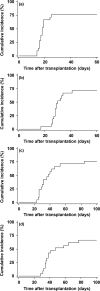Phase II study of intrabone single unit cord blood transplantation for hematological malignancies
- PMID: 28582607
- PMCID: PMC5543458
- DOI: 10.1111/cas.13291
Phase II study of intrabone single unit cord blood transplantation for hematological malignancies
Abstract
The outcomes of cord blood transplantation with non-irradiated reduced-intensity conditioning for hematological malignancies need to be improved because of graft failure and delayed engraftment. Intrabone infusion of cord blood cells has the potential to resolve the problems. In this phase II study, 21 adult patients with hematological malignancy received intrabone transplantation of serological HLA-A, B, and DR ≥4/6 matched single cord blood with a median number of cryopreserved total nucleated cells of 2.7 × 107 /kg (range, 2.0-4.9 × 107 /kg) following non-irradiated fludarabine-based reduced-intensity conditioning. Short-term methotrexate and tacrolimus were given as graft-versus-host disease prophylaxis, and granulocyte colony-stimulating factor was given after transplantation. No severe adverse events related to intrabone injection were observed. The cumulative incidences of neutrophils ≥0.5 × 109 /L, reticulocytes ≥1%, and platelets ≥20 × 109 /L recoveries were 76.2%, 71.4%, and 76.2%, respectively, with median time to recoveries of 17, 28, and 32 days after transplantation, respectively. The probability of survival with neutrophil engraftment on day 60 was 71.4%, and overall survival at 1 year after transplantation was 52.4%. The incidences of grade II-IV and III-IV acute graft-versus-host disease were 44% and 19%, respectively, with no cases of chronic graft-versus-host disease. The present study showed the safety of direct intrabone infusion of cord blood. Further analysis is required to confirm the efficacy of intrabone single cord blood transplantation with non-irradiated reduced-intensity conditioning for adult patients with hematological malignancy. This study was registered with UMIN-CTR, number 000000865.
Keywords: Cord blood transplantation; engraftment; hematological malignancy; intrabone; non-myeloablative conditioning.
© 2017 The Authors. Cancer Science published by John Wiley & Sons Australia, Ltd on behalf of Japanese Cancer Association.
Figures

Similar articles
-
A multicenter phase II study of intrabone single-unit cord blood transplantation without antithymocyte globulin.Ann Hematol. 2021 Mar;100(3):743-752. doi: 10.1007/s00277-020-04365-z. Epub 2021 Jan 11. Ann Hematol. 2021. PMID: 33427909 Clinical Trial.
-
A prospective multicenter phase II study of intrabone marrow transplantation of unwashed cord blood using reduced-intensity conditioning.Eur J Haematol. 2018 Apr;100(4):335-343. doi: 10.1111/ejh.12999. Epub 2018 Jan 17. Eur J Haematol. 2018. PMID: 29168236 Clinical Trial.
-
[Comparison of intensified myeloablative conditioning regime without antithymocytic globulin (ATG) with myeloablative conditioning regime for single-unit unrelated umbilical cord blood transplantation in hematological malignancies].Zhonghua Yi Xue Za Zhi. 2016 Jul 26;96(28):2214-9. doi: 10.3760/cma.j.issn.0376-2491.2016.28.003. Zhonghua Yi Xue Za Zhi. 2016. PMID: 27480651 Chinese.
-
Concise review: umbilical cord blood transplantation: past, present, and future.Stem Cells Transl Med. 2014 Dec;3(12):1435-43. doi: 10.5966/sctm.2014-0151. Epub 2014 Nov 5. Stem Cells Transl Med. 2014. PMID: 25378655 Free PMC article. Review.
-
Omidubicel: First Approval.Mol Diagn Ther. 2023 Sep;27(5):637-642. doi: 10.1007/s40291-023-00662-1. Epub 2023 Jun 24. Mol Diagn Ther. 2023. PMID: 37354365 Review.
Cited by
-
A multicenter phase II study of intrabone single-unit cord blood transplantation without antithymocyte globulin.Ann Hematol. 2021 Mar;100(3):743-752. doi: 10.1007/s00277-020-04365-z. Epub 2021 Jan 11. Ann Hematol. 2021. PMID: 33427909 Clinical Trial.
-
Umbilical cord blood derived cellular therapy: advances in clinical development.Front Oncol. 2023 May 18;13:1167266. doi: 10.3389/fonc.2023.1167266. eCollection 2023. Front Oncol. 2023. PMID: 37274288 Free PMC article. Review.
-
Phase I study of cord blood transplantation with intrabone marrow injection of mesenchymal stem cells: A clinical study protocol.Medicine (Baltimore). 2018 Apr;97(17):e0449. doi: 10.1097/MD.0000000000010449. Medicine (Baltimore). 2018. PMID: 29702996 Free PMC article. Clinical Trial.
-
Mechanisms of Chimeric Cell Therapy in Duchenne Muscular Dystrophy.Biomedicines. 2024 Sep 2;12(9):1996. doi: 10.3390/biomedicines12091996. Biomedicines. 2024. PMID: 39335509 Free PMC article.
-
Phase I clinical trial of intra-bone marrow cotransplantation of mesenchymal stem cells in cord blood transplantation.Stem Cells Transl Med. 2021 Apr;10(4):542-553. doi: 10.1002/sctm.20-0381. Epub 2020 Dec 14. Stem Cells Transl Med. 2021. PMID: 33314650 Free PMC article. Clinical Trial.
References
-
- Terakura S, Atsuta Y, Tsukada N et al Comparison of outcomes of 8/8 and 7/8 allele‐matched unrelated bone marrow transplantation and single‐unit cord blood transplantation in adults with acute leukemia. Biol Blood Marrow Transplant 2016; 22: 330–8. - PubMed
-
- Cutler C, Ballen K. Reduced‐intensity conditioning and umbilical cord blood transplantation in adults. Bone Marrow Transplant 2009; 44: 667–71. - PubMed
-
- Chao NJ, Koh LP, Long GD et al Adult recipients of umbilical cord blood transplants after nonmyeloablative preparative regimens. Biol Blood Marrow Transplant 2004; 10: 569–75. - PubMed
-
- Komatsu T, Narimatsu H, Yoshimi A et al Successful engraftment of mismatched unrelated cord blood transplantation following reduced intensity preparative regimen using fludarabine and busulfan. Ann Hematol 2007; 86: 49–54. - PubMed
Publication types
MeSH terms
Substances
LinkOut - more resources
Full Text Sources
Other Literature Sources
Research Materials

